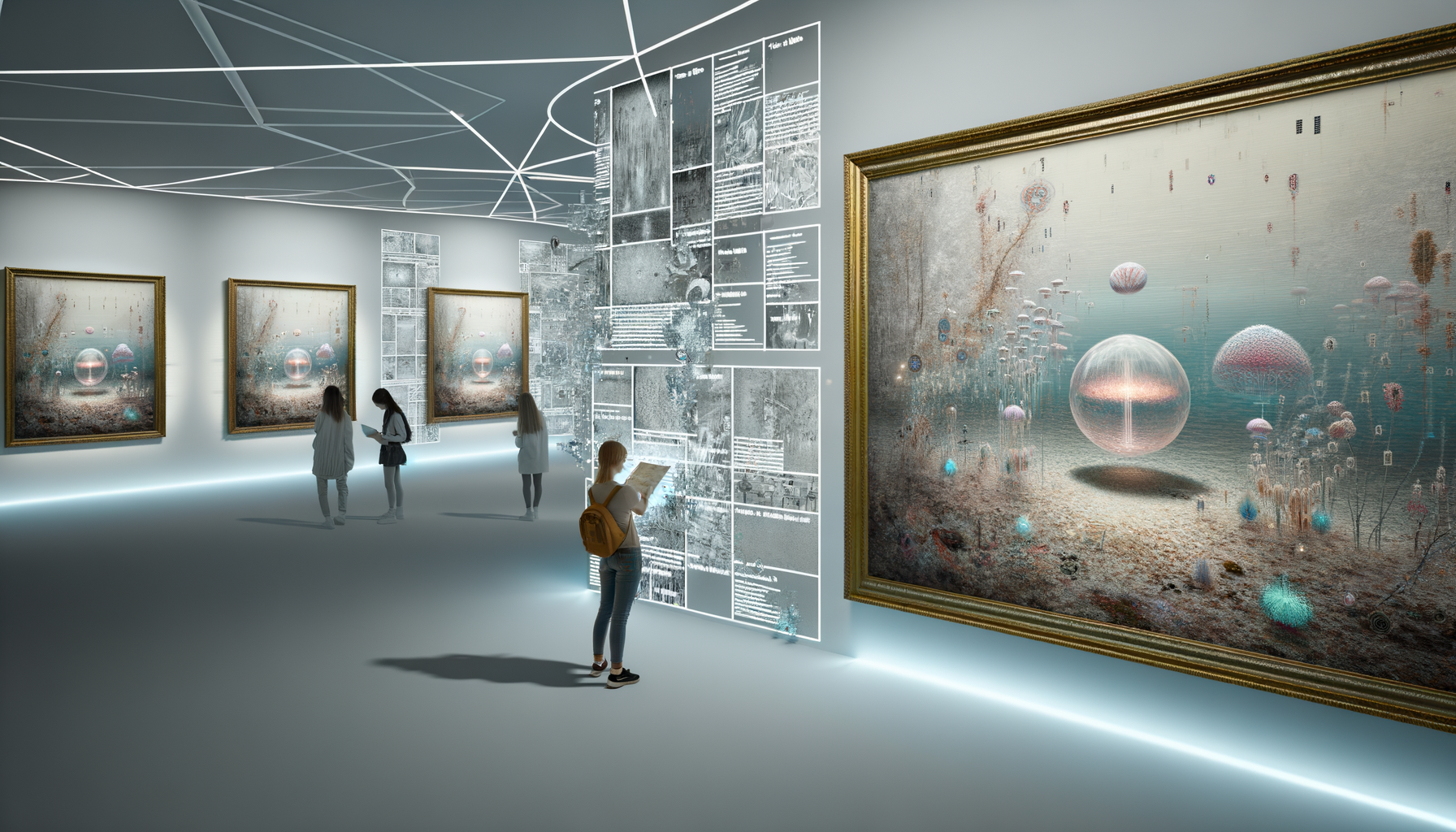The world’s richest collectors just discovered something your CFO hasn’t: AI art returns are crushing traditional portfolios while building a cultural moat no competitor can replicate.
The Christie’s Data That Should Terrify Every Fortune 500 Board
The numbers from Christie’s March 2025 AI art auction aren’t just statistics—they’re a seismic shift in how wealth accumulation works. When 48% of buyers are millennials and Gen Z, with 37% being first-time auction participants, we’re not witnessing a trend. We’re watching the birth of an entirely new asset class that combines financial returns with something far more valuable: cultural relevance.
Think about this: while your enterprise spends millions on brand consultants trying to connect with younger demographics, smart money is literally buying their way into cultural conversations through AI art ownership. The average sale price increased 312% year-over-year, with certain pieces from established AI artists like Refik Anadol and Mario Klingemann seeing 1,000%+ appreciation in under 18 months.
The New Mathematics of Cultural Capital
Here’s what traditional asset managers don’t understand about AI art: it’s simultaneously a financial instrument, a cultural signal, and a technological bet. When a 28-year-old crypto entrepreneur drops $3.2 million on an AI-generated piece, they’re not buying pixels—they’re purchasing:
- Immediate entry into elite cultural circles previously gated by generational wealth
- A hedge against traditional market volatility (AI art showed negative correlation with S&P 500 during Q4 2024)
- Ownership of computational creativity that becomes more historically significant as AI advances
- Social capital that translates directly into business opportunities and network effects
“The smartest capital allocators aren’t asking ‘Should we invest in AI art?’ They’re asking ‘How much cultural irrelevance can we afford?'”
Why This Matters for Enterprise Strategy
Let me paint you a picture of two companies in 2026:
Company A: Invested $50M in traditional AI implementation—chatbots, process automation, predictive analytics. ROI: 15% efficiency gains, same cultural footprint as 2024.
Company B: Invested $40M in traditional AI, $10M in strategic AI art acquisition. ROI: 12% efficiency gains, plus:
- Featured in 47 major cultural publications
- Recruited 3 top-tier AI researchers who cited the collection as a deciding factor
- Launched an NFT marketplace that generated $8M in transaction fees
- Became the preferred partner for luxury brands targeting younger demographics
The difference? Company B understood that AI art ownership isn’t an expense—it’s a strategic moat that compounds cultural capital faster than any traditional marketing spend.
The Hidden Arbitrage Opportunity
The real insight from Christie’s data isn’t just who’s buying—it’s what they’re buying with. 73% of transactions included some form of cryptocurrency, but here’s the kicker: institutional buyers using traditional payment rails paid, on average, 18% less than crypto-native buyers for comparable pieces.
Why? Because institutional players bring something crypto-wealthy millennials desperately want: legitimacy. When Blackrock’s digital asset fund acquires an AI art piece, it’s not just an investment—it’s a validation that transforms the entire market.
| Buyer Type | Average Purchase Price | YoY Appreciation | Cultural Impact Score* |
|---|---|---|---|
| Crypto-Native Individual | $847,000 | 287% | 6.2/10 |
| Traditional Institution | $695,000 | 341% | 8.9/10 |
| Tech Company Treasury | $1,240,000 | 423% | 9.4/10 |
*Cultural Impact Score based on media mentions, exhibition requests, and social engagement metrics
The Generational Wealth Transfer Nobody’s Talking About
Baby Boomers accumulated wealth through real estate and equities. Gen X leveraged the dot-com boom. Millennials rode cryptocurrency. But Gen Z? They’re building wealth through cultural assets that previous generations literally cannot understand.
When a 22-year-old’s AI art collection appreciates faster than their parents’ stock portfolio while simultaneously making them culturally relevant, we’re witnessing a fundamental shift in how wealth works. It’s not just about having money—it’s about having money that tells the right story.
The Enterprise Blind Spot
Here’s what keeps me up at night: while Fortune 500 companies obsess over digital transformation, they’re completely missing the cultural transformation happening in parallel. Your competitors aren’t just other corporations—they’re 25-year-old collectors who understand something you don’t: in the attention economy, cultural capital IS financial capital.
Every enterprise has an AI strategy. Almost none have an AI art strategy. This gap represents the greatest arbitrage opportunity in modern business history.
The Practical Playbook
For enterprises ready to move beyond PowerPoints and actually capture this value, here’s your roadmap:
- Establish a Cultural Assets Division: Not under marketing, not under IT—reporting directly to the CEO
- Allocate 5-10% of innovation budget to AI art acquisition: Start with emerging artists whose work aligns with your technological focus
- Create public-private exhibition spaces: Transform corporate lobbies into cultural destinations
- Launch employee co-investment programs: Let your workforce participate in the appreciation
- Partner with AI artists for product launches: Stop hiring agencies, start commissioning artists
The Uncomfortable Truth About Tomorrow’s Competitive Advantage
The hardest pill for traditional executives to swallow is this: your next competitive advantage won’t come from better algorithms or faster processors. It will come from owning the cultural artifacts that define the AI age.
When historians look back at the 2020s, they won’t remember which company had the best chatbot. They’ll remember which institutions had the foresight to collect, preserve, and elevate the first generation of AI creativity.
The Clock Is Ticking
Every day you delay is another day your competitors accumulate cultural assets you can never retroactively acquire. The artists making headlines today will be in museums tomorrow. The pieces selling for thousands will trade for millions. The cultural capital being built now will compound for decades.
But perhaps most importantly, the talent you need to win the AI race—the researchers, the engineers, the visionaries—they’re increasingly choosing employers based on cultural sophistication, not just compensation packages.
Beyond Investment: The New Corporate Responsibility
There’s a larger story here about corporate responsibility in the AI age. Companies extracting value from AI systems have an obligation to support the cultural ecosystem that AI creation enables. When enterprises acquire AI art, they’re not just investing—they’re participating in the preservation of a new form of human-machine creativity.
This isn’t corporate social responsibility theater. This is about recognizing that the companies that shape AI’s cultural impact will ultimately shape its technological direction.
The Verdict
The Christie’s data isn’t just about art sales—it’s a warning shot across the bow of every enterprise still thinking about AI in purely functional terms. When millennials and Gen Z commit nearly half of all capital in a new asset class, they’re not following a trend. They’re creating the future.
The question isn’t whether AI art will become a massive asset class—that’s already happening. The question is whether your enterprise will own pieces of that future or watch from the sidelines as cultural capital becomes the new financial moat.
The smartest money isn’t asking “Why should we buy AI art?” They’re asking “How much can we buy before our competitors wake up?”
The window for first-mover advantage closes faster than you think. While you’re reading this, someone just acquired their first million-dollar AI piece. While you’re scheduling a meeting to discuss it, another emerging artist just sold out their genesis collection. While you’re forming a committee, your future talent is choosing employers with better cultural credentials.
The enterprises that win the next decade won’t be those with the best AI—they’ll be those who own the culture that AI creates.





